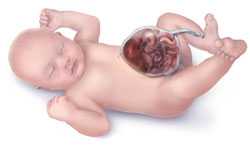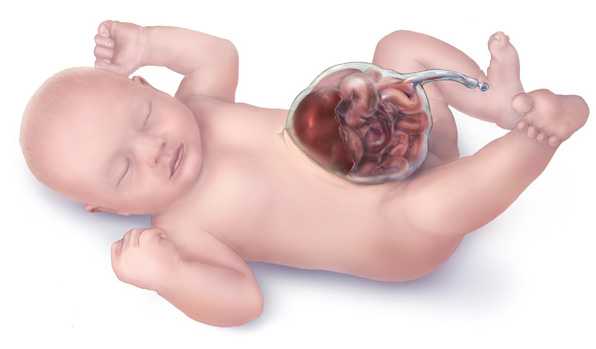Facts about Omphalocele
Omphalocele (pronounced uhm-fa-lo-seal) is a birth defect of the abdominal (belly) wall. The infant’s intestines, liver, or other organs stick outside of the belly through the belly button. The organs are covered in a thin, nearly transparent sac that hardly ever is open or broken.
What is Omphalocele?
Omphalocele, also known as exomphalos, is a birth defect of the abdominal (belly) wall. The infant’s intestines, liver, or other organs stick outside of the belly through the belly button. The organs are covered in a thin, nearly transparent sac that hardly ever is open or broken.
As the baby develops during weeks six through ten of pregnancy, the intestines get longer and push out from the belly into the umbilical cord. By the eleventh week of pregnancy, the intestines normally go back into the belly. If this does not happen, an omphalocele occurs. The omphalocele can be small, with only some of the intestines outside of the belly, or it can be large, with many organs outside of the belly.
Jude's Story

Jude was born with omphalocele. Read his story as well as other stories from families affected by omphalocele »
Other Problems
Because some or all of the abdominal (belly) organs are outside of the body, babies born with an omphalocele can have other problems. The abdominal cavity, the space in the body that holds these organs, might not grow to its normal size. Also, infection is a concern, especially if the sac around the organs is broken. Sometimes, an organ might become pinched or twisted, and loss of blood flow might damage the organ.
Occurrence
The Centers for Disease Control and Prevention (CDC) estimates that each year about 775 babies in the United States are born with an omphalocele.1 In other words, about 1 out of every 5,386 babies born in the United States each year is born with an omphalocele. Many babies born with an omphalocele also have other birth defects, such as heart defects, neural tube defects, and chromosomal abnormalities.2
Causes and Risk Factors
The causes of omphalocele among most infants are unknown. Some babies have omphalocele because of a change in their genes or chromosomes. Omphalocele might also be caused by a combination of genes and other factors, such as the things the mother comes in contact with in the environment or what the mother eats or drinks, or certain medicines she uses during pregnancy.
Like many families affected by birth defects, we at CDC want to find out what causes them. Understanding factors that are more common among babies with a birth defect will help us learn more about the causes. CDC funds the Centers for Birth Defects Research and Prevention, which collaborate on large studies such as the National Birth Defects Prevention Study (NBDPS; births 1997-2011), to understand the causes of and risks for birth defects, such as omphalocele.
Recently, CDC researchers have reported important findings about some factors that can affect the risk of having a baby with an omphalocele:
- Alcohol and tobacco: Women who consumed alcohol or were heavy smokers (more than 1 pack a day) were more likely to have a baby with omphalocele.3
- Certain medications: Women who used selective serotonin-reuptake inhibitors (SSRIs) during pregnancy were more likely to have a baby with an omphalocele.4
- Obesity: Women who were obese or overweight before pregnancy were more likely to have a baby with an omphalocele.5
CDC continues to study birth defects such as omphalocele and how to prevent them. If you are pregnant or thinking about getting pregnant, talk with your doctor about ways to increase your chances of having a healthy baby.
Diagnosis
An omphalocele can be diagnosed during pregnancy or after a baby is born.
During Pregnancy
During pregnancy, there are screening tests (prenatal tests) to check for birth defects and other conditions. An omphalocele might result in an abnormal result on a blood or serum screening test or it might be seen during an ultrasound (which creates pictures of the baby).
After a Baby Is Born
In some cases, an omphalocele might not be diagnosed until after a baby is born. An omphalocele is seen immediately at birth.
Treatments
Treatment for infants with an omphalocele depends on a number of factors, including
- the size of the omphalocele,
- the presence of other birth defects or chromosomal abnormalities, and
- the baby’s gestational age.
If the omphalocele is small (only some of the intestine is outside of the belly), it usually is treated with surgery soon after birth to put the intestine back into the belly and close the opening. If the omphalocele is large (many organs outside of the belly), the repair might be done in stages. The exposed organs might be covered with a special material, and slowly, over time, the organs will be moved back into the belly. When all the organs have been put back in the belly, the opening is closed.
Other Resources
The views of this organization are its own and do not reflect the official position of CDC.
- Omphalocele.net
Omphalocele.net provides support and encouragement to families who may be expecting a child with omphalocele, be connected with a child with omphalocele, and to people who were born with omphalocele.
References
- Parker SE, Mai CT, Canfield MA, Rickard R, Wang Y, Meyer RE, et al; for the National Birth Defects Prevention Network. Updated national birth prevalence estimates for selected birth defects in the United States, 2004-2006. Birth Defects Res A Clin Mol Teratol. 2010;88(12):1008-16.
- Stoll C, Alembik Y, Dott B, Roth MP. Omphalocele and gastroschisis and associated malformations. Am J Med Genet A. 2008 May 15;146A(10):1280-5.
- Bird TM, Robbins JM, Druschel C, Cleves MA, Yang S, Hobbs CA, & the National Birth Defects Prevention Study . Demographic and environmental risk factors for gastroschisis and omphalocele in the National Birth Defects Prevention Study. J Pediatr Surg, 2009;44:1546-1551.
- Alwan S, Reefhuis J, Rasmussen SA, Olney RS, Friedman JM, & the National Birth Defects Prevention Study. Use of Selective Serotonin-Reuptake Inhibitors in Pregnancy and the Risk of Birth Defects. N Engl J Med, 2007;356:2684-92.
- Waller DK, Shaw GM, Rasmussen SA, Hobbs CA, Canfield MA, Siega-Riz AM, Gallaway MS, Correa A, & the National Birth Defects Prevention Study. Prepregnancy obesity as a risk factor for structural birth defects. Arch Pediatr Adolesc Med, 2007;161(8):745-50.
- Page last reviewed: June 27, 2017
- Page last updated: November 17, 2015
- Content source:



 ShareCompartir
ShareCompartir

